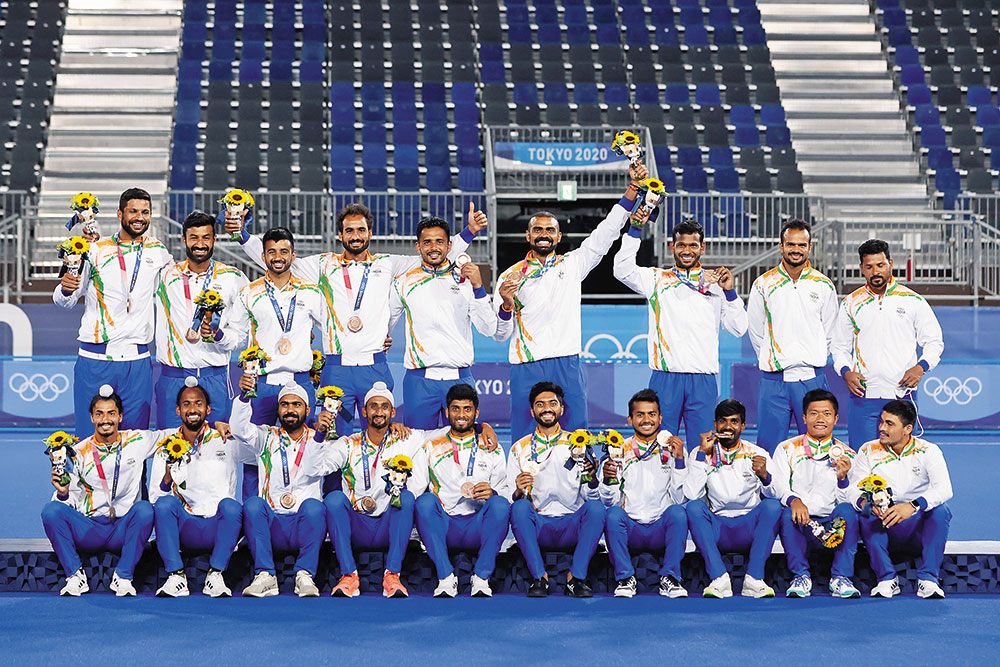When Neeraj Chopra’s javelin moved through the warm Tokyo air to land at the 87.58-metre mark, a tiny village in northwest India, located 5,847 kilometres away from the Japanese capital, lit up in joy. The joy spread like wildfire to engulf a sixth of humanity. Within hours, children carrying sticks double or sometimes triple their size came out on the streets and started throwing what they imagined were javelins. And a country of 1.4 billion people celebrated its first track-and-field gold at the biggest sporting event in the world.
Four years have since passed by.
Later this month at the Paris Olympics India will not set the Seine on fire, for sure. A couple of trinkets more than the seven we won at Tokyo will get the country preening. However, there is a silent revolution happening. More and more Indians are taking up football, athletics, basketball and a bunch of other activities at a young age. And parents do not mind.
Mugdha Kapoor, 34, a journalist with a national daily, enrolled her four-year-old son at a football academy in Noida. “This year, during the summer vacation, I first took him for karate. He did not like the ‘fighting’,” she says. So, she then took him for skating lessons. “He is having a lovely time and really enjoying himself,” she says. Asked if she thinks she would be fine if her son went on to build a career in sports, she says, “Absolutely. As long as he is successful and happy doing it.”
Kapoor is not alone. “Parents now base their decision on which school to send their child based on the sports that are available,” says Sudeep Kulkarni, founder of Game Theory, a sports training business based out of Bengaluru.
Ready, Set, Go
The past 10 years have seen serious and sustained investment in sports in India. The Union government, last year, budgeted Rs 3,442 crore for the Ministry of Youth Affairs and Sports, the highest-ever allocation for the ministry. States have stepped up their investments.
Private organisations have also stepped in. Indian companies spent an average Rs 248 crore a year on sports through corporate social responsibilty (CSR) funds between 2019 and 2022, according to
Prime Database.

GroupM ESP, a media investment management company, calculated that India’s sports industry was worth an estimated Rs 15,000 crore by the end of 2023. The bulk of this money came from sponsorships and endorsements. Cricket, of course, had the largest share—87%.
Behind the scenes, India is seeing sports academies mushroom across its bigger cities. These academies are looking to offer infrastructure as good as anywhere else in the world. Technology is becoming an integral part of the training method and there is active investment in the development of a sporting culture in the country.
After winning six medals at the 2012 London Olympics, Indian athletes returned with just two medals from Rio in 2016. “The performance at Rio was a wake-up call,” says Mustafa Ghouse, founder and general partner at Centre Court Capital, a venture capital firm focused on sports technology.
Speaking to Outlook Business, Ghouse says that after 2016 there has been a consolidated effort to improve athletes. In 2021, at the Tokyo Olympics, India registered its best performance in history. At the 2022 Commonwealth Games, India secured 61 medals.
These performances in turn propelled an active interest in sports. Big Indian business houses started pouring CSR funds into sports. “The number of corporate groups involved in sports or are using their CSR budgets for the growth of sports has gone up I would say 10–15 times in the past five–seven years,” says Ghouse.
Loosening Purse Strings
While corporates are beginning to pour money into sports, both Union and state governments, are doing their part. In October 2017, the Union government started Khelo India—a programme with the stated aim of reviving the sports culture in India at the grassroots level and allocated Rs 1,756 crore to it.
Specific states are also topping up their sports budgets. Odisha is a shining example. The state has organised back-to-back Hockey World Cups (2018 and 2023), the FIFA Under-17 Women’s World Cup and the South Asian Football Federation (SAFF) U-20 Championship. Over the past four years, it has raised its sports budget to Rs 1,217 crore.
Tamil Nadu is attempting to make it big in sports. The government has plans to set up four Olympic academies across the state—in Chennai, Madurai, Tiruchi and the Nilgiris. These academies will not only train athletes but also serve as centres for sports science. A sum of Rs 440 crore has been allocated for this scheme.
Kulkarni sees the rising interest in sports among parents of young children as a factor of rising disposable incomes. “With rising disposable incomes, parents can spare a larger share of the wallet for their children to pursue sports,” he says.
According to him, back in 2018–19 there were about 15,000 sports venues that were open to the public. He based his Game Theory idea on being able to monetise these. “In these 15,000 [venues], we can see that we can hit around Rs 2 crore per annum. That gives us an estimated $3 billion market in India.”
The shift in the attitude towards sports is palpable, says Saumil Majmudar, chief executive and managing director of Sportz Village. His organisation ties up with school administrations for sports programmes.
He has been in the sports business since the early 2000s. “In 2008–09, when I had to knock on school doors to talk about sports programmes, I had to convince them of why sports. I had to say I am an IIT-Bombay graduate, an IIM-Bangalore alum, I also played sports. So, believe me when I say sports education is important.”

That Moment in the Economy
India today is the fifth-largest economy in the world, and the fastest-growing. This, while it is also the most populous nation in the world and the youngest. Yet among the major economies, India’s sports performance is dismal. The United States, the world’s largest economy, won 113 medals at Tokyo. China, the second largest, won 88. Germany, the third largest, won 37 while Japan, the fourth largest, won 58.
India’s gross domestic product at the end of 2023–24 was around $3 trillion. China became a $3.5 trillion-economy in 2007. The next year, at the Beijing Olympics, the country won 100 medals. Until the early 1990s, Chinese investment in sports was mostly controlled by the state.
A 2008 paper by economist Severine Bardon titled The Economics of Sport in China: A Maturing Sector, says the situation began to change when a professional football championship was set up in 1994. That is when, “China cautiously opened up to outside investment, clubs were urged to raise funds from local enterprises, the championship sought private sponsorship, and a sports market gradually emerged”.
In India, the emergence of the Indian Premier League (IPL), one of the most highly valued sporting events in the world today, was a game changer. Initiated in 2008, IPL brought the franchise spirit to India’s favourite sport.
The success of the IPL led to a series of professional commercial sports leagues coming into being—the Indian Super League (ISL) for football, Pro-Kabaddi, Hockey India League, Premier Badminton League, Ultimate Table Tennis League and Prime Volleyball League. Franchise sports have played a big part in helping talented athletes find a viable profession in sports, says Ghouse.
“You have a fixed contract. You get into the kabaddi league, you can make Rs 10–20 lakh as an entry-level player,” he adds.
Growth of a Community
The kind of exposure a particular sport gets versus the others or the sport a young budding athlete chooses relies on rationale that does not immediately become apparent but makes sense once seen in context. Parents nowadays choose sports so that their child can secure a seat at a university (often in the West), says Kulkarni of Game Theory. So sometimes they will attempt somewhat obscure sports like squash, he says.
For Majmudar of Sportz Village, the creation of good athletes and a sustainable sports economy depends on the way the sports ecosystem treats its athletes. “Parental and coach pressure are the biggest reasons for kids dropping out of sports. Both these pressures come because the assumption is you should keep performing better and therefore you get a scholarship or a job,” he says.
Megha Gambhir, chief executive and co-founder of Stupa Sports Analytics, has been trying to solve this problem through technology. Her company designs products that offer primarily racquet-sports players artificial intelligence-based technical support to improve performance.
For a long time, Indians have stayed away from the serious pursuit of sports. But now, at a time when the economy has created resources that can accommodate the pursuit, it is imperative that investments are made to strengthen the nation’s sports culture.











 Just one email a week
Just one email a week